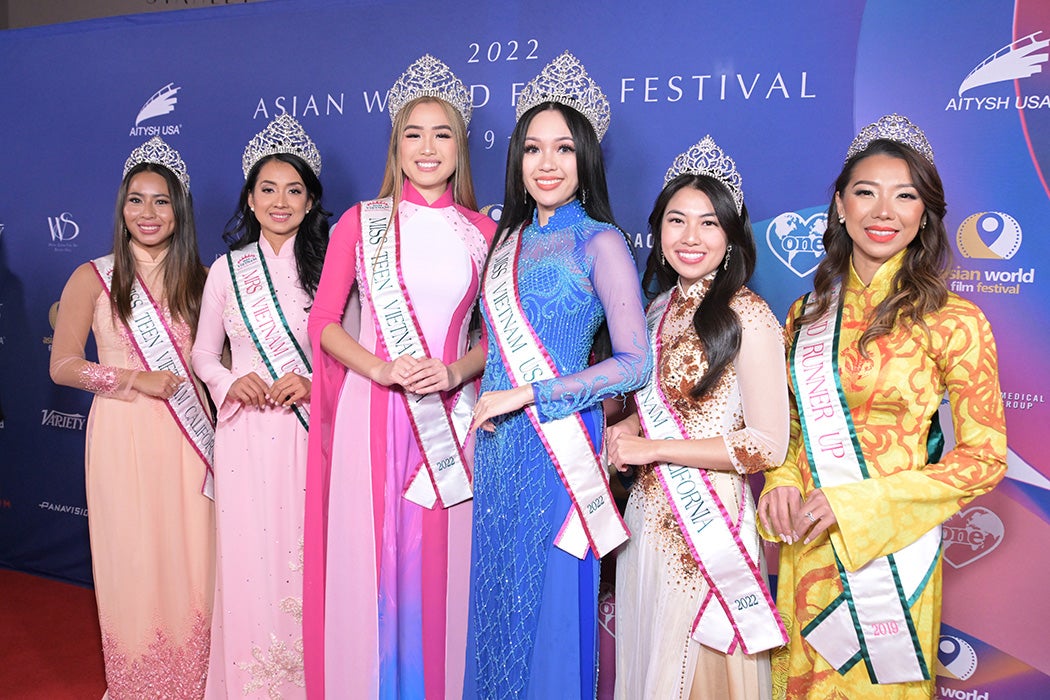Fibbing on your résumé generally looks bad. But when Miss Vietnam USA 2004 turned out to have lied about having a college diploma, a local politician and pageant judge came out to defend her, arguing that “education and a college degree is not a requirement of the contest.”
The brouhaha speaks to a larger question about the purpose of the beauty pageants popular in post-refugee Vietnamese diasporic communities, according to scholar Nhi T. Lieu.
Lieu, who has also investigated the significance of the unique ao dai segment of these pageants, argues that the events have drifted from an initial goal of cultural preservation to becoming “sites that celebrate and venerate capitalist success, financial wealth, and conspicuous consumption.”
Diasporic Vietnamese beauty pageants started taking off in the United States in the 1980s, following in the footsteps of earlier ethnic pageants such as Miss Chinatown USA. In the beginning, community-based pageants “prioritized ‘culture, language, and tradition,’” Lieu writes. But these supposedly laudable values are not neutral. Instead, they’re enmeshed in considerations of “morality, female sexuality, and public display of the female body.”
The original organizers of Miss Tet Vietnam, which Lieu describes as “the largest pageant in northern California,” put the kibosh on a bathing-suit segment in 1987, citing the need for Miss Tet to be “an icon of intelligence, wholesomeness and inner as well as outer beauty.” In fact, decades later, Miss Tet Vietnam 2004 was forced to resign after organizers learned that she had once posed nude out of financial necessity while in college.
In contrast, Lieu notes that the Miss Vietnam USA winner’s embellished résumé was tolerated, since “she had told a ‘good lie’ to fortify her educational accomplishments,” which conformed with the model minority discourse that presumes Asian American academic excellence. The contrasting treatment of two winners may reflect a shift in Vietnamese pageants’ objectives.
“Unlike the Miss Tet pageant…the MVU (Miss Vietnam USA) competition was premised on feminine beauty and attractiveness,” Lieu adds. “The MVU pageant, with its excessive cash prize and its luxury sports car, was in sharp contrast to the Miss Tet pageant.”
The ao dai, once seen as the quintessential symbol of Vietnamese culture and femininity, has fallen by the wayside in pageants—as has the earlier requirement for Vietnamese language skills. Writes Lieu,
While it would be more practical to keep the Vietnamese language as a requirement, for it also served as the lingua franca for the diaspora, pageant organizers recognized the reality of assimilation, favored mass participation, and prioritized the commercial appeal of their pageants.
Over time, diasporic beauty pageants—which had initially set out “to solidify an identity of exile through cultural nationalism,” in contrast with the communist nation-state—even allowed Vietnamese nationals to compete, to broaden their audiences and win transnational sponsors. Participation criteria also points to renegotiation over who is best equipped “to represent Vietnameseness,” as Lieu found during her examination of the entry requirements for Miss Vietnam Global Pageant.
For instance, the global pageant excludes transgender women and emphasizes “moral and chaste values” by allowing only participants who have never been married or pregnant. In specifying that contestants should be “1/4 Vietnamese or at least understanding the Vietnamese language,” the rules also reflect racial beliefs that exoticize mixed-race women, Lieu observes.
Ultimately, ethnic pageants are wedded to a paradoxical model of femininity, even more than in mainstream beauty competitions.
Weekly Newsletter
“Women are expected to uphold a sense of prudish morality by containing their sexual desires, yet to flaunt their sexuality and to be judged by their flirtatious performance of it,” says Lieu. The events thus “simultaneously demand that young women be cultural representatives of their communities and encourage them to use their appearance to gain fame and recognition.”
As such, Lieu concludes, that “the dynamics within these beauty pageants serve as a microcosm and a lens through which we can learn about the Vietnamese diaspora and the struggle of its people to forge new identities amid forces of globalization.”
Three Tips for Teaching:
Watch a recent Miss Vietnam (USA) pageant. The Miss Vietnam Florida 2022 pageant includes an Ao Dai segment, an evening gown segment, a talent segment, and a general questionnaire segment.
Use fiction to put this article in context. Pair this with E. M. Tran’s Daughters of the New Year or another diasporic novel. Or start with JSTOR Daily stories on Monique Truong’s The Book of Salt and Lan Cao’s Monkey Bridge.
Support JSTOR Daily! Join our membership program on Patreon today.







